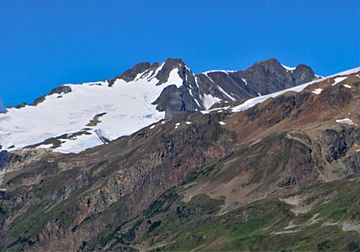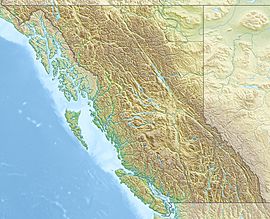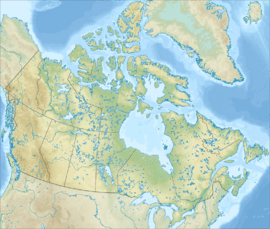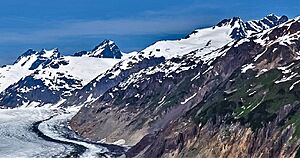Mount White-Fraser facts for kids
Quick facts for kids Mount White-Fraser |
|
|---|---|

Mount White-Fraser, east aspect
|
|
| Highest point | |
| Elevation | 2,331 m (7,648 ft) |
| Prominence | 526 m (1,726 ft) |
| Geography | |
| Location | British Columbia, Canada |
| Parent range | Boundary Ranges Coast Mountains |
| Topo map | NTS 104B/01 |
Mount White-Fraser is a tall, icy mountain in British Columbia, Canada. It stands about 2,331 meters (7,648 feet) high. This mountain is part of the Boundary Ranges, which are a section of the larger Coast Mountains.
You can find Mount White-Fraser about 31 kilometers (19 miles) northwest of a town called Stewart. It's also 10 kilometers (6 miles) northwest of another mountain, Mount Bayard. Water from the mountain, including melted ice from the nearby Salmon Glacier, flows into the Salmon River.
The mountain got its name from a person named George White-Fraser (1872-1920). He was part of the International Boundary Survey team. He also served as a soldier for Canada during World War I in France. The mountain's name became official on March 31, 1924. If the weather is clear, you might even see Mount White-Fraser from the Granduc Mine Road, which is near Hyder, Alaska. This road is usually open during the summer.
Weather and Climate
Mount White-Fraser is located in a special climate zone called the marine west coast climate. This type of climate is found in western North America. It means the area gets a lot of rain and snow.
Most of the weather systems, like big clouds and storms, start over the Pacific Ocean. They then travel east towards the Coast Mountains. When these weather systems hit the tall mountains, they are forced to rise up. As the air goes higher, it cools down and drops its moisture. This process is called Orographic lift.
Because of this, the Coast Mountains get a lot of precipitation. This is especially true in winter, when most of it falls as snow. Temperatures on Mount White-Fraser can get very cold, sometimes dropping below -20°C (-4°F). With the wind, it can feel even colder, below -30°C (-22°F)!




